Numerical Investigation of Thermal Energy Storage Systems for Collective Heating of Buildings
Abstract
1. Introduction
2. System Description
3. Physical Modelling and Validation
- For the HTF medium:
- For the storage medium (Sensible or latent):
4. Results and Discussion
4.1. TES Functioning Analysis
4.2. Comparative Study
4.3. Parametric Study
- (a)
- 33% PCM RT70, 33% PCM RT64, 33% PCM RT54
- (b)
- 80% PCM RT70, 10% PCM RT64, 10% PCM RT54
- (c)
- 10% PCM RT70, 80% PCM RT64, 10% PCM RT54
- (d)
- 10% PCM RT70, 10% PCM RT64, 80% PCM RT54
5. Conclusions
- In comparison to sensible systems, the latent and cascade latent TES showed greater thermal energy storage capabilities, underscoring their potential for effective DH networks.
- Using a single PCM tank increases the duration of constant thermal power storage by about 50% compared to the sensible TES.
- Using a cascade PCM tank further enhances the TES performance and increases this duration of constant thermal power production by approximately 65% compared to the sensible TES case.
- The distribution of PCM within cascade TES proved pivotal in influencing system performance. It is demonstrated that the optimal cascade configuration—10% PCM RT70, 80% PCM RT64, 10% PCM RT54—showcased prolonged stable thermal power production and reduced pump energy consumption.
- The use of a cascade PCM enhances the tank energy efficiency and reduces pumping energy consumption by approximately 30% when compared to both single PCM tanks and sensible water tank systems.
Author Contributions
Funding
Data Availability Statement
Acknowledgments
Conflicts of Interest
References
- European Commission. In Focus: Energy Efficiency in Buildings; European Commission: Brussels, Belgium, 2023.
- Ju, Y.; Hiltunen, P.; Jokisalo, J.; Kosonen, R.; Syri, S. Benefits through Space Heating and Thermal Storage with Demand Response Control for a District-Heated Office Building. Buildings 2023, 13, 2670. [Google Scholar] [CrossRef]
- IAE. Tracking Clean Energy Progress 2023; IAE: Paris, France, 2023. [Google Scholar]
- IAE District-Heating. Available online: https://www.iea.org/reports/district-heating (accessed on 20 November 2023).
- Lyu, Y.; Pan, Y.; Huang, Z. Development and Test of a New Fast Estimate Tool for Cooling and Heating Load Prediction of District Energy Systems at Planning Stage. Buildings 2022, 12, 1671. [Google Scholar] [CrossRef]
- Lebrouhi, B.E.; Schall, E.; Lamrani, B.; Chaibi, Y.; Kousksou, T. Energy Transition in France. Sustainability 2022, 14, 5818. [Google Scholar] [CrossRef]
- Lund, H.; Werner, S.; Wiltshire, R.; Svendsen, S.; Thorsen, J.E.; Hvelplund, F.; Mathiesen, B.V. 4th Generation District Heating (4GDH). Integrating Smart Thermal Grids into Future Sustainable Energy Systems. Energy 2014, 68, 1–11. [Google Scholar] [CrossRef]
- Averfalk, H.; Werner, S. Economic Benefits of Fourth Generation District Heating. Energy 2020, 193, 116727. [Google Scholar] [CrossRef]
- Ajbar, A.; Lamrani, B.; Ali, E. Dynamic Investigation of a Coupled Parabolic Trough Collector—Phase Change Material Tank for Solar Cooling. Energies 2023, 16, 4235. [Google Scholar] [CrossRef]
- Siddiqui, S.; Macadam, J.; Barrett, M. The Operation of District Heating with Heat Pumps and Thermal Energy Storage in a Zero-Emission Scenario. Energy Rep. 2021, 7, 176–183. [Google Scholar] [CrossRef]
- Narula, K.; de Oliveira Filho, F.; Villasmil, W.; Patel, M.K. Simulation Method for Assessing Hourly Energy Flows in District Heating System with Seasonal Thermal Energy Storage. Renew. Energy 2020, 151, 1250–1268. [Google Scholar] [CrossRef]
- Wang, J.; Evans, M.; Belusko, M.; Zhao, C.; Liu, M.; Bruno, F. Subcooling Effect on the Optimal Performance for a Transcritical CO2 Heat Pump with Cold Thermal Energy Storage. Heat Mass Transf. 2023, 59, 1257–1275. [Google Scholar] [CrossRef]
- Eynard, J.; Grieu, S.; Polit, M. Predictive Control and Thermal Energy Storage for Optimizing a Multi-Energy District Boiler. J. Process. Control. 2012, 22, 1246–1255. [Google Scholar] [CrossRef][Green Version]
- Shah, S.K.; Aye, L.; Rismanchi, B. Seasonal Thermal Energy Storage System for Cold Climate Zones: A Review of Recent Developments. Renew. Sustain. Energy Rev. 2018, 97, 38–49. [Google Scholar] [CrossRef]
- Ali, E.; Ajbar, A.; Lamrani, B. Modeling and Dynamic Simulation of a Phase-Change Material Tank for Powering Chiller Generators in District Cooling Networks. Sustainability 2023, 15, 10332. [Google Scholar] [CrossRef]
- Turski, M.; Sekret, R. Buildings and a District Heating Network as Thermal Energy Storages in the District Heating System. Energy Build. 2018, 179, 49–56. [Google Scholar] [CrossRef]
- Bentivoglio, F.; Rouge, S.; Soriano, O.; Tempass de Sousa, A. Design and Operation of a 180 KWh PCM Heat Storage at the Flaubert Substation of the Grenoble Urban Heating Network. Appl. Therm. Eng. 2021, 185, 116402. [Google Scholar] [CrossRef]
- Griffiths, P.; Hewitt, G. Heat Exchanger Design Handbook; Begell House: New York, NY, USA, 1990. [Google Scholar]
- Pans, M.A.; Claudio, G.; Eames, P.C. Theoretical Cost and Energy Optimisation of a 4th Generation Net-Zero District Heating System with Different Thermal Energy Storage Technologies. Sustain. Cities Soc. 2024, 100, 105064. [Google Scholar] [CrossRef]
- Mao, Q.; Zhang, Y. Thermal Energy Storage Performance of a Three-PCM Cascade Tank in a High-Temperature Packed Bed System. Renew. Energy 2020, 152, 110–119. [Google Scholar] [CrossRef]
- Wu, M.; Xu, C.; He, Y. Cyclic Behaviors of the Molten-Salt Packed-Bed Thermal Storage System Filled with Cascaded Phase Change Material Capsules. Appl. Therm. Eng. 2016, 93, 1061–1073. [Google Scholar] [CrossRef]
- Khor, J.O.; Sze, J.Y.; Li, Y.; Romagnoli, A. Overcharging of a Cascaded Packed Bed Thermal Energy Storage: Effects and Solutions. Renew. Sustain. Energy Rev. 2020, 117, 109421. [Google Scholar] [CrossRef]
- Lamrani, B.; Kousksou, T. Numerical Investigation of a Shell-and-Tube Latent Heat Thermal Energy Storage System for Urban Heating Network. J. Energy Storage 2021, 43, 103216. [Google Scholar] [CrossRef]
- Hassanpour, A.; Borji, M.; Ziapour, B.M.; Kazemi, A. Performance Analysis of a Cascade PCM Heat Exchanger and Two-Phase Closed Thermosiphon: A Case Study of Geothermal District Heating System. Sustain. Energy Technol. Assess. 2020, 40, 100755. [Google Scholar] [CrossRef]
- Nekoonam, S.; Ghasempour, R. Modeling and Optimization of a Thermal Energy Storage Unit with Cascaded PCM Capsules in Connection to a Solar Collector. Sustain. Energy Technol. Assess. 2022, 52, 102197. [Google Scholar] [CrossRef]
- Aldoss, T.K.; Rahman, M.M. Comparison between the Single-PCM and Multi-PCM Thermal Energy Storage Design. Energy Convers. Manag. 2014, 83, 79–87. [Google Scholar] [CrossRef]
- Elfeky, K.E.; Ahmed, N.; Wang, Q. Numerical Comparison between Single PCM and Multi-Stage PCM Based High Temperature Thermal Energy Storage for CSP Tower Plants. Appl. Therm. Eng. 2018, 139, 609–622. [Google Scholar] [CrossRef]
- Shen, Y.; Mazhar, A.R.; Liu, S. Comprehensive Review on Cascaded Latent Heat Storage Technology: Recent Advances and Challenges. J. Energy Storage 2022, 55, 105713. [Google Scholar] [CrossRef]
- Li, X.; Yilmaz, S.; Patel, M.K.; Chambers, J. Techno-Economic Analysis of Fifth-Generation District Heating and Cooling Combined with Seasonal Borehole Thermal Energy Storage. Energy 2023, 285, 129382. [Google Scholar] [CrossRef]
- Sadeghi, H.; Jalali, R.; Singh, R.M. A Review of Borehole Thermal Energy Storage and Its Integration into District Heating Systems. Renew. Sustain. Energy Rev. 2024, 192, 114236. [Google Scholar] [CrossRef]
- Jebamalai, J.M.; Marlein, K.; Laverge, J. Influence of Centralized and Distributed Thermal Energy Storage on District Heating Network Design. Energy 2020, 202, 117689. [Google Scholar] [CrossRef]
- Yang, X.; Svendsen, S. Improving the District Heating Operation by Innovative Layout and Control Strategy of the Hot Water Storage Tank. Energy Build. 2020, 224, 110273. [Google Scholar] [CrossRef]
- Rubitherm. Available online: http://www.rubitherm.eu (accessed on 1 April 2022).
- Mostafavi, S.S.; Taylor, R.A.; Saberi, P.; Diarce, G. Design and Feasibility of High Temperature Shell and Tube Latent Heat Thermal Energy Storage System for Solar Thermal Power Plants. Renew. Energy 2016, 96, 120–136. [Google Scholar] [CrossRef]
- Elbahjaoui, R.; El Qarnia, H. Thermal Performance of a Solar Latent Heat Storage Unit Using Rectangular Slabs of Phase Change Material for Domestic Water Heating Purposes. Energy Build. 2019, 182, 111–130. [Google Scholar] [CrossRef]
- Lamrani, B.; Khouya, A.; Zeghmati, B.; Draoui, A. Mathematical Modeling and Numerical Simulation of a Parabolic Trough Collector: A Case Study in Thermal Engineering. Therm. Sci. Eng. Prog. 2018, 8, 47–54. [Google Scholar] [CrossRef]
- Gnielinski, V. On Heat Transfer in Tubes. Int. J. Heat Mass Transf. 2013, 63, 134–140. [Google Scholar] [CrossRef]
- Medved, I.; Trník, A.; Vozár, L. Modeling of Heat Capacity Peaks and Enthalpy Jumps of Phase-Change Materials Used for Thermal Energy Storage. Int. J. Heat Mass Transf. 2017, 107, 123–132. [Google Scholar] [CrossRef]
- Halimov, A.; Lauster, M.; Müller, D. Validation and Integration of a Latent Heat Storage Model into Building Envelopes of a High-Order Building Model for Modelica Library AixLib. Energy Build. 2019, 202, 109336. [Google Scholar] [CrossRef]
- Feustel, H. Simplified Numerical Description of Latent Storage Characteris—Tics for Phase Change Wallboard; Lawrence Berkeley National Lab. (LBNL): Berkeley, CA, USA, 1995.
- Lamrani, B.; Lebrouhi, B.E.; Khattari, Y.; Kousksou, T. A Simplified Thermal Model for a Lithium-Ion Battery Pack with Phase Change Material Thermal Management System. J. Energy Storage 2021, 44, 103377. [Google Scholar] [CrossRef]
- El Ouali, A.; Khattari, Y.; Lamrani, B.; El Rhafiki, T.; Zeraouli, Y.; Kousksou, T. Apparent Heat Capacity Method to Describe the Thermal Performances of a Latent Thermal Storage System during Discharge Period. J. Energy Storage 2022, 52, 104960. [Google Scholar] [CrossRef]


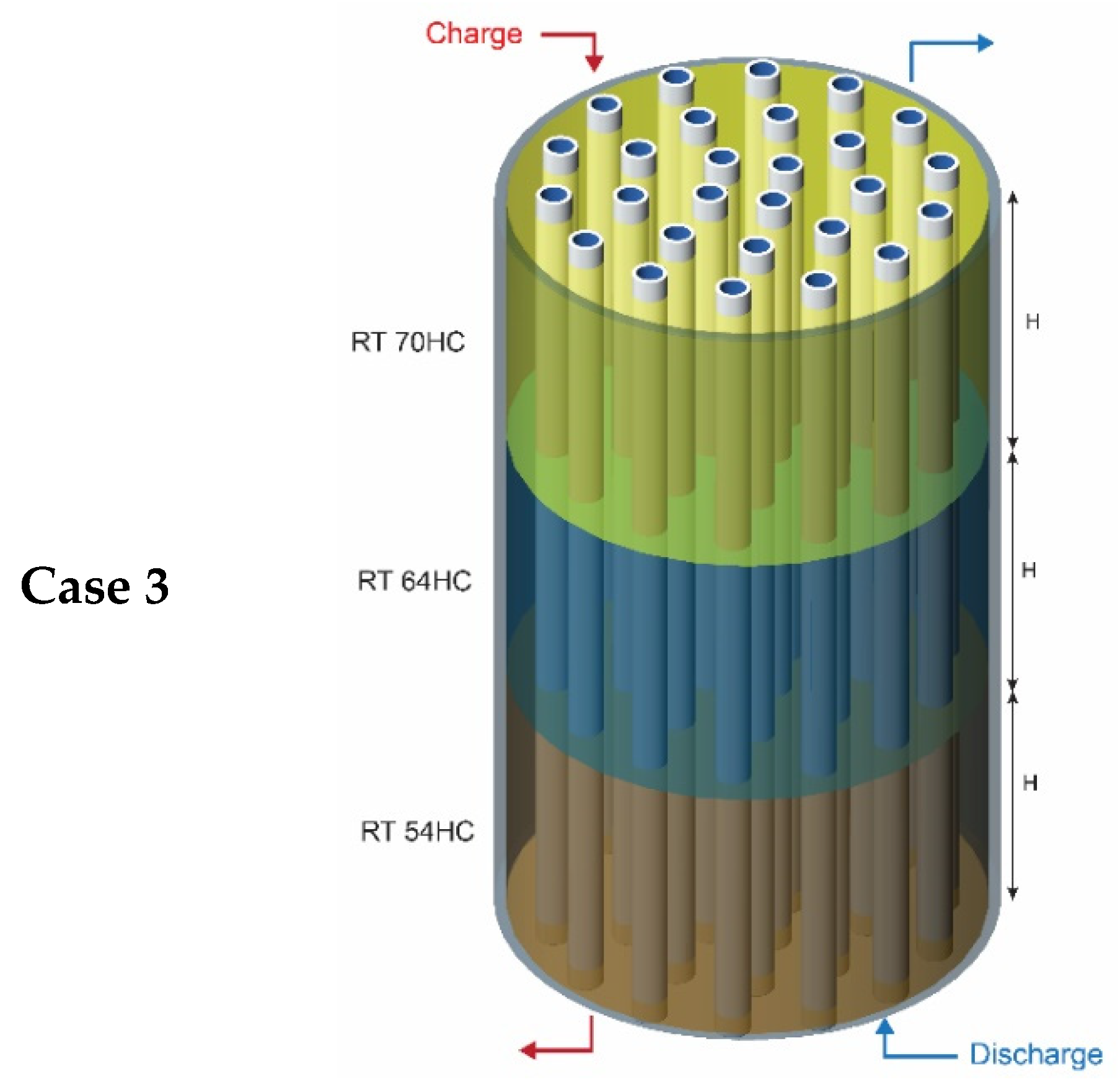
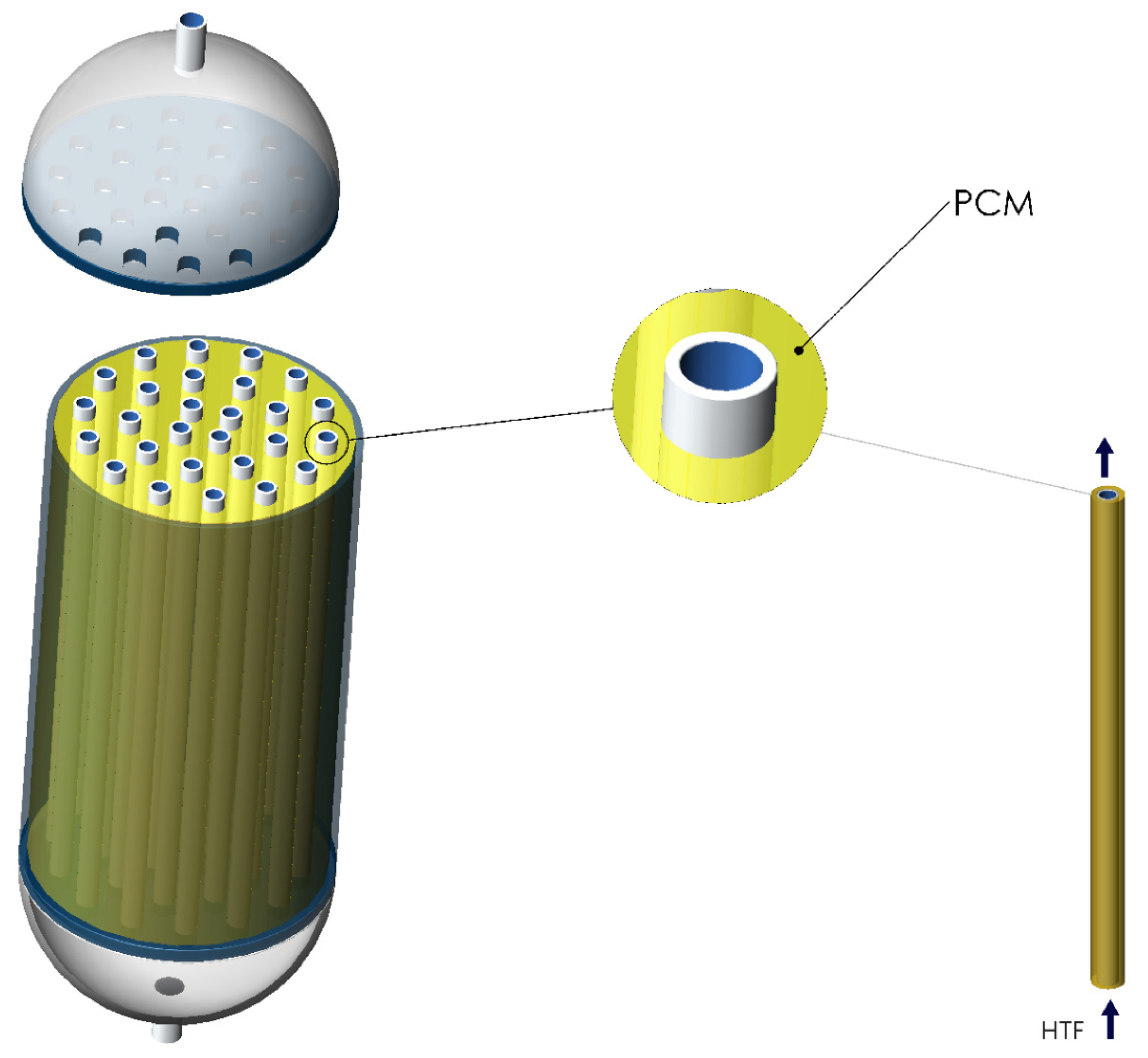
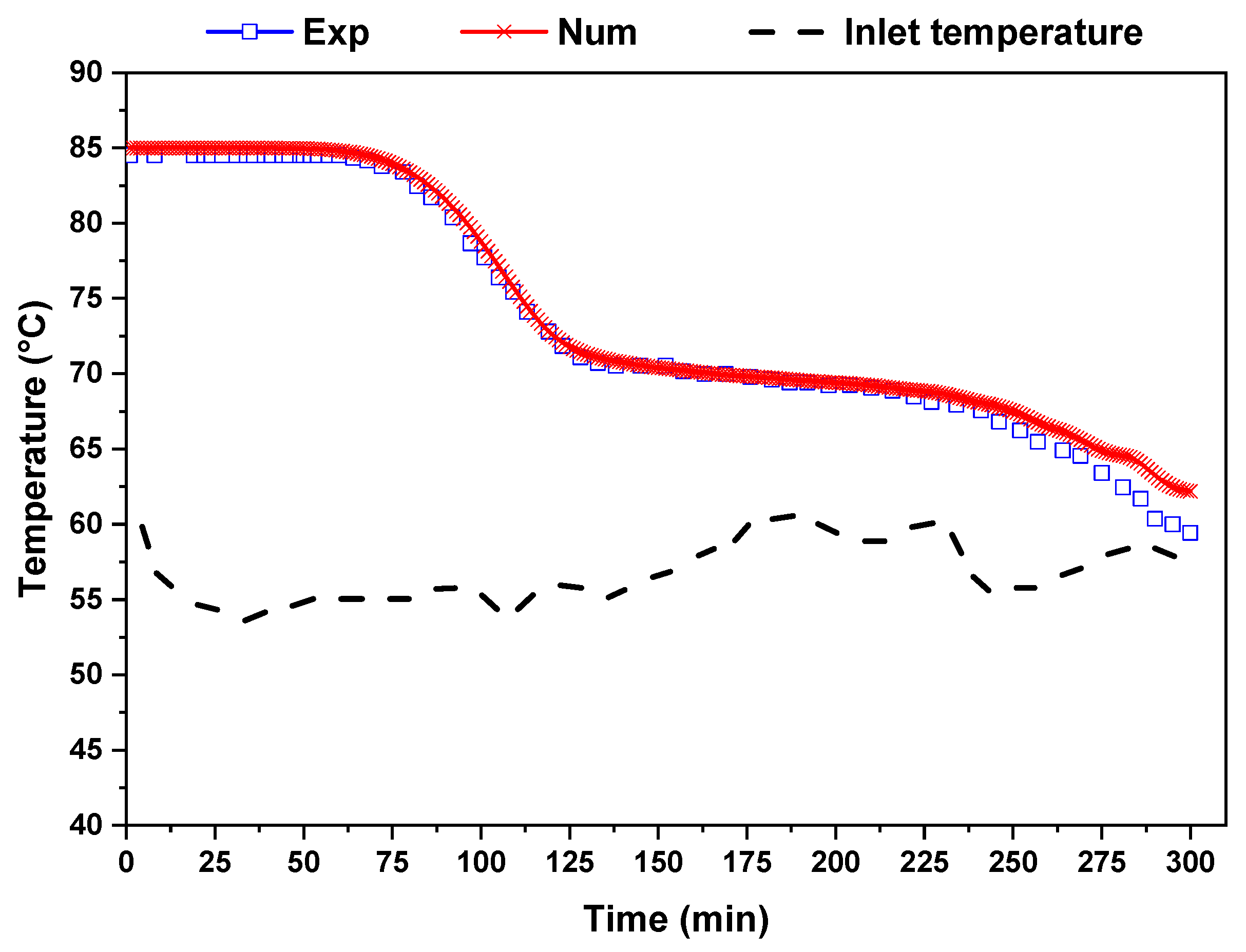
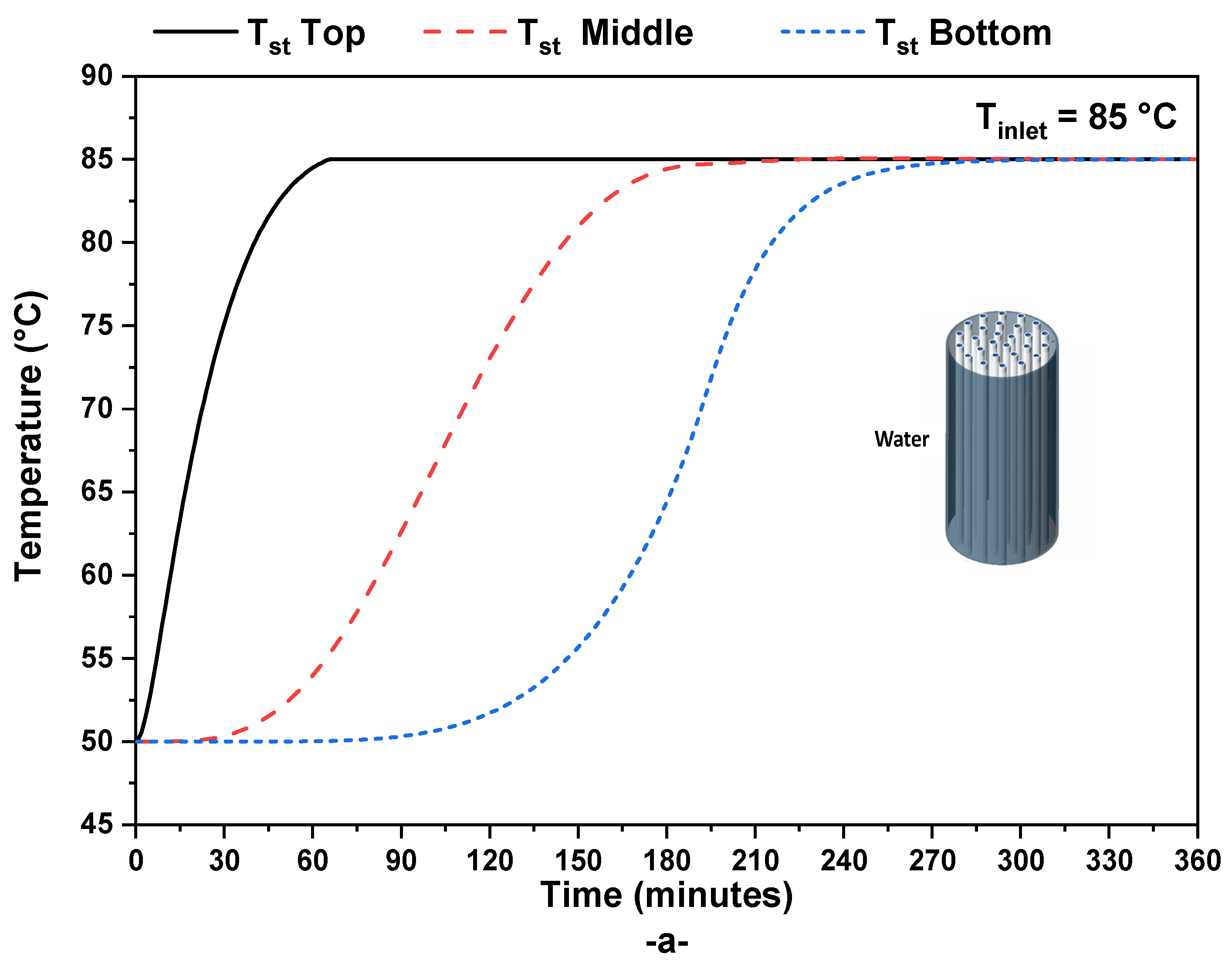
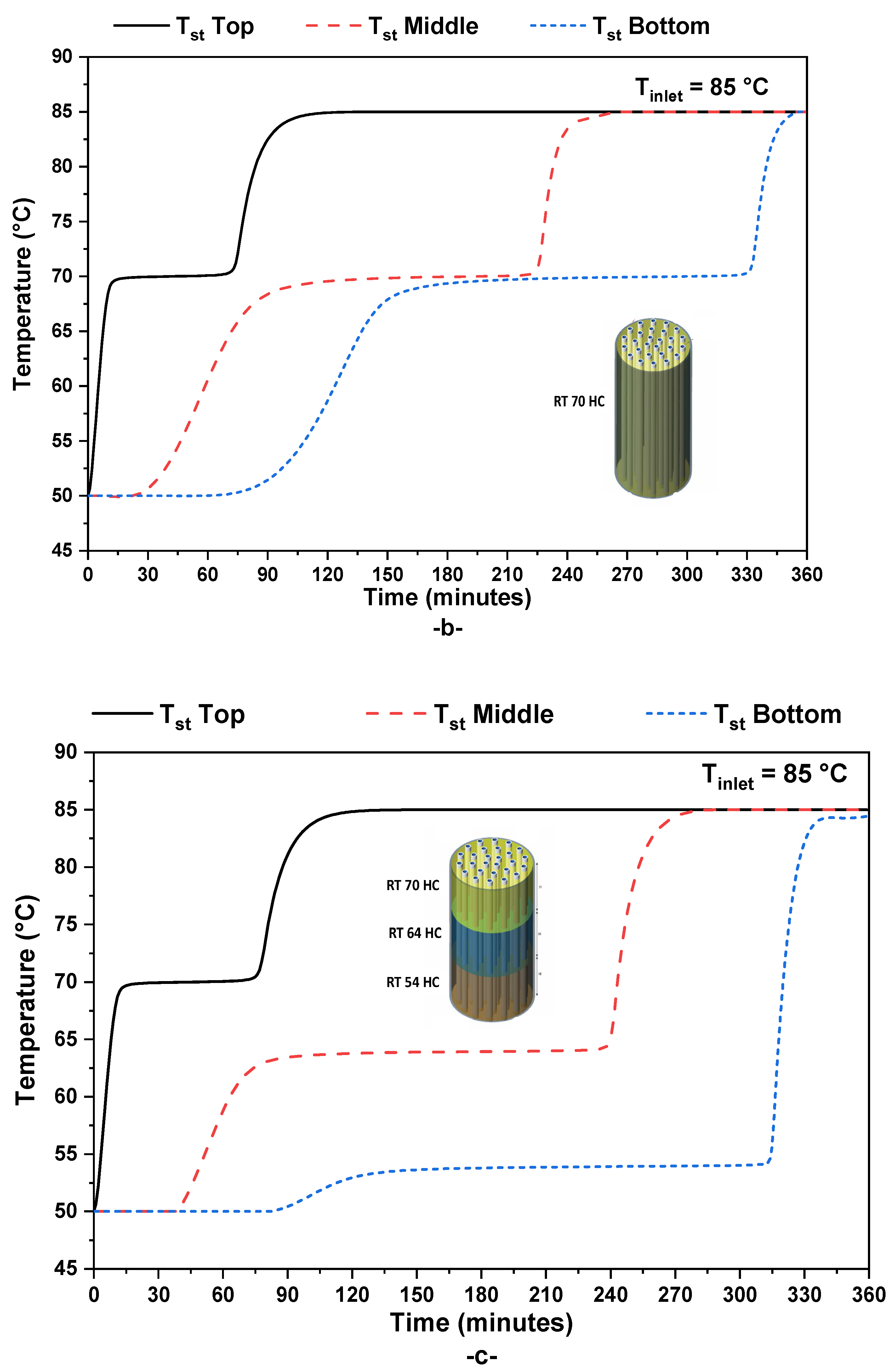
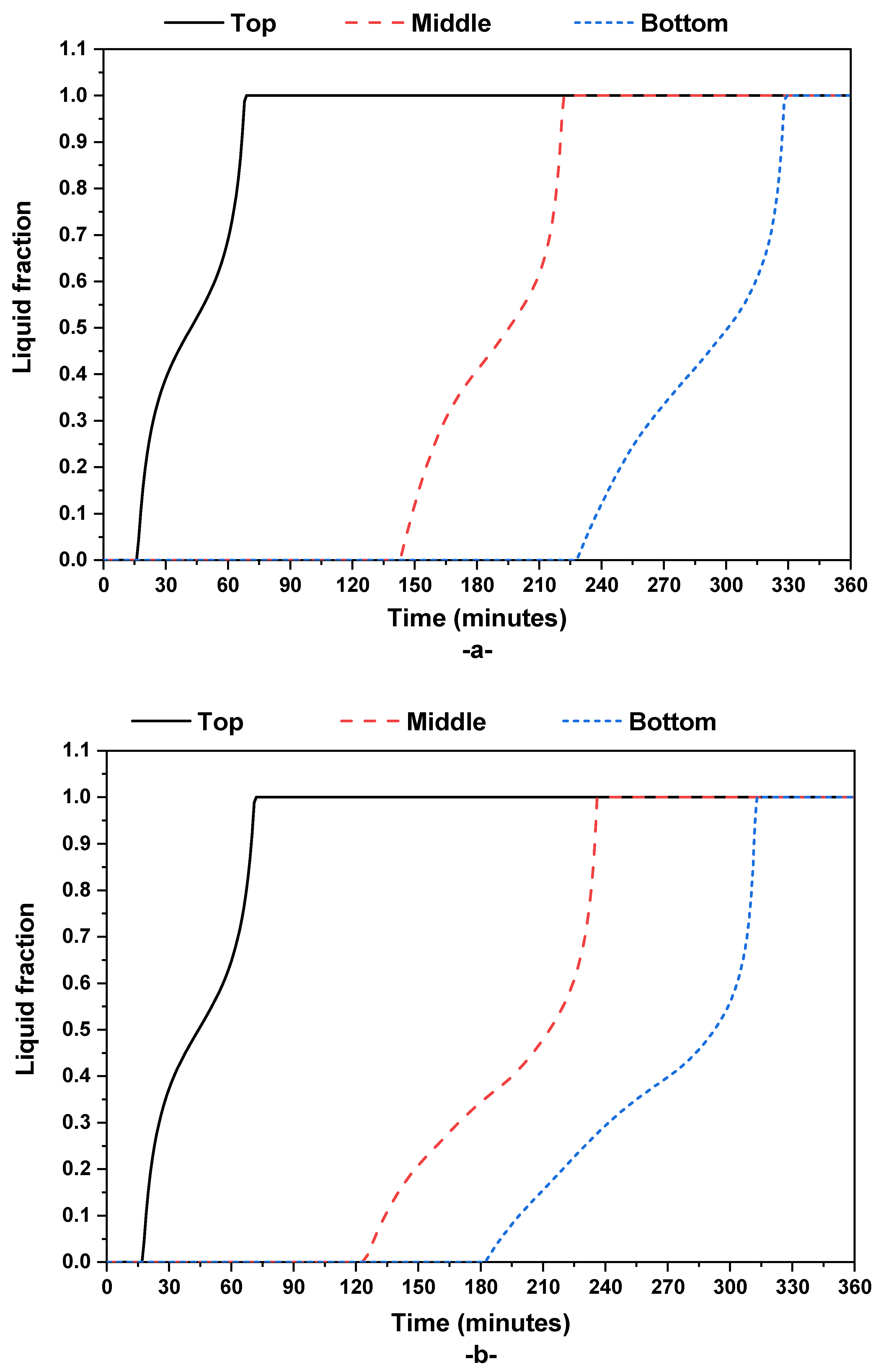
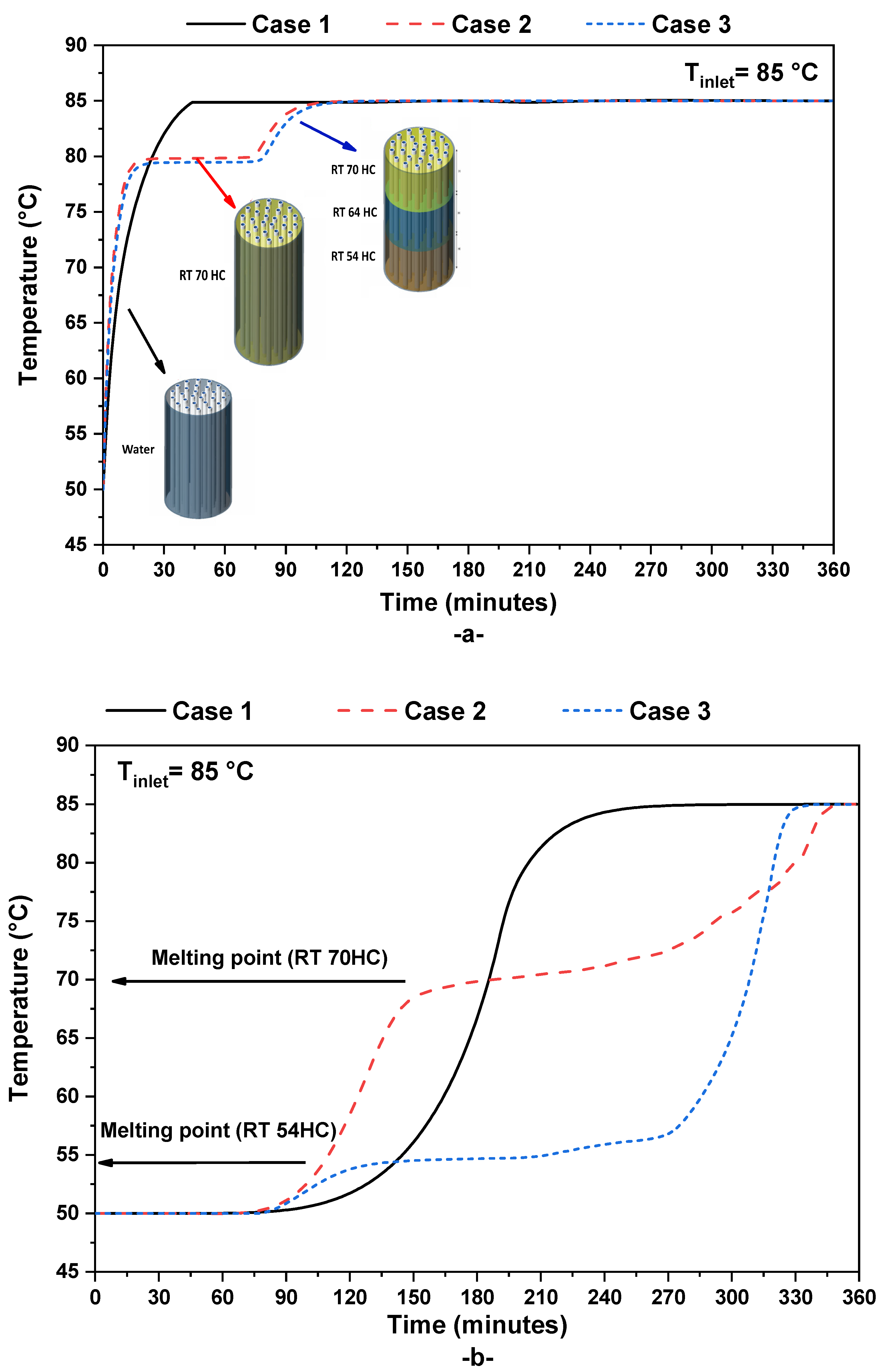
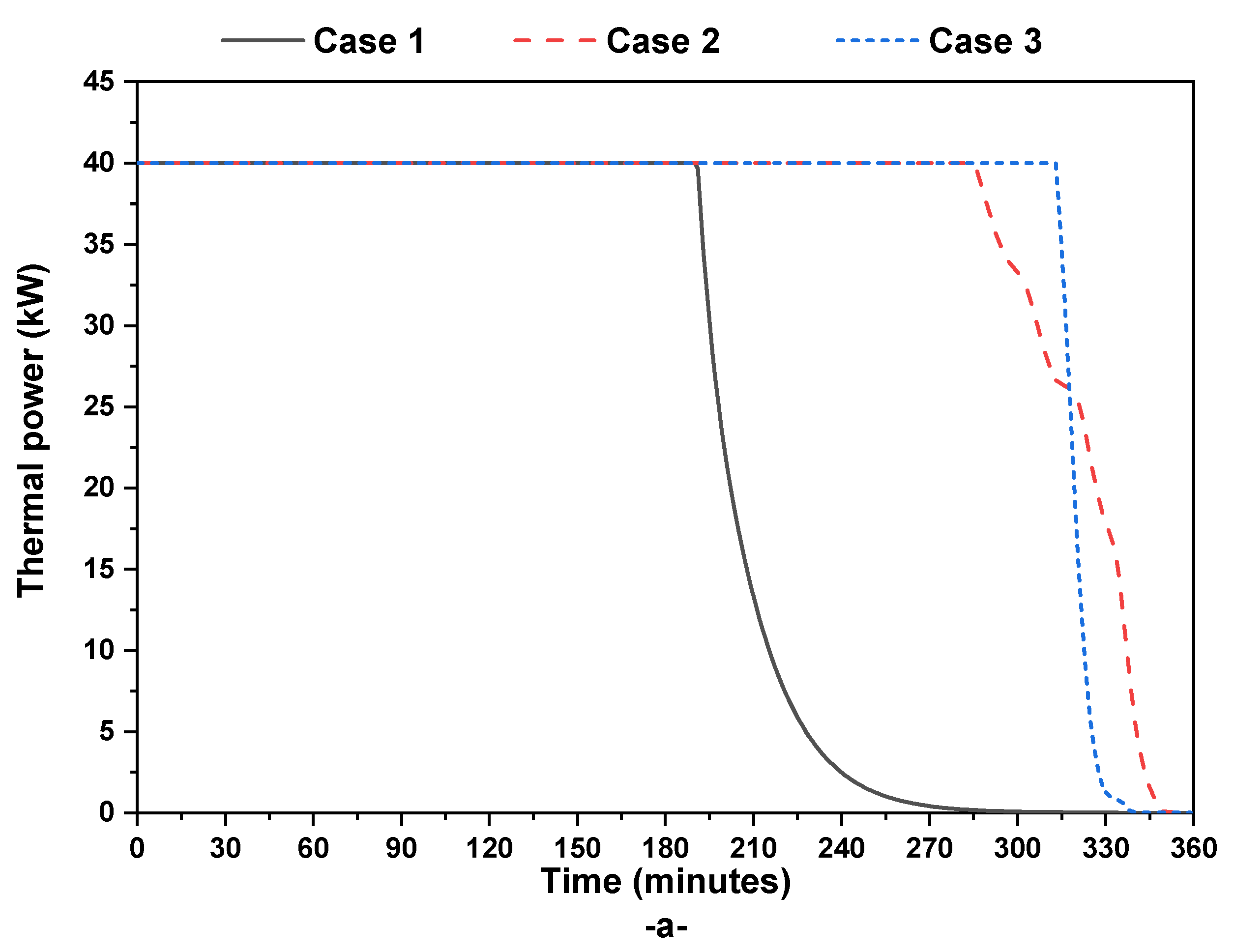
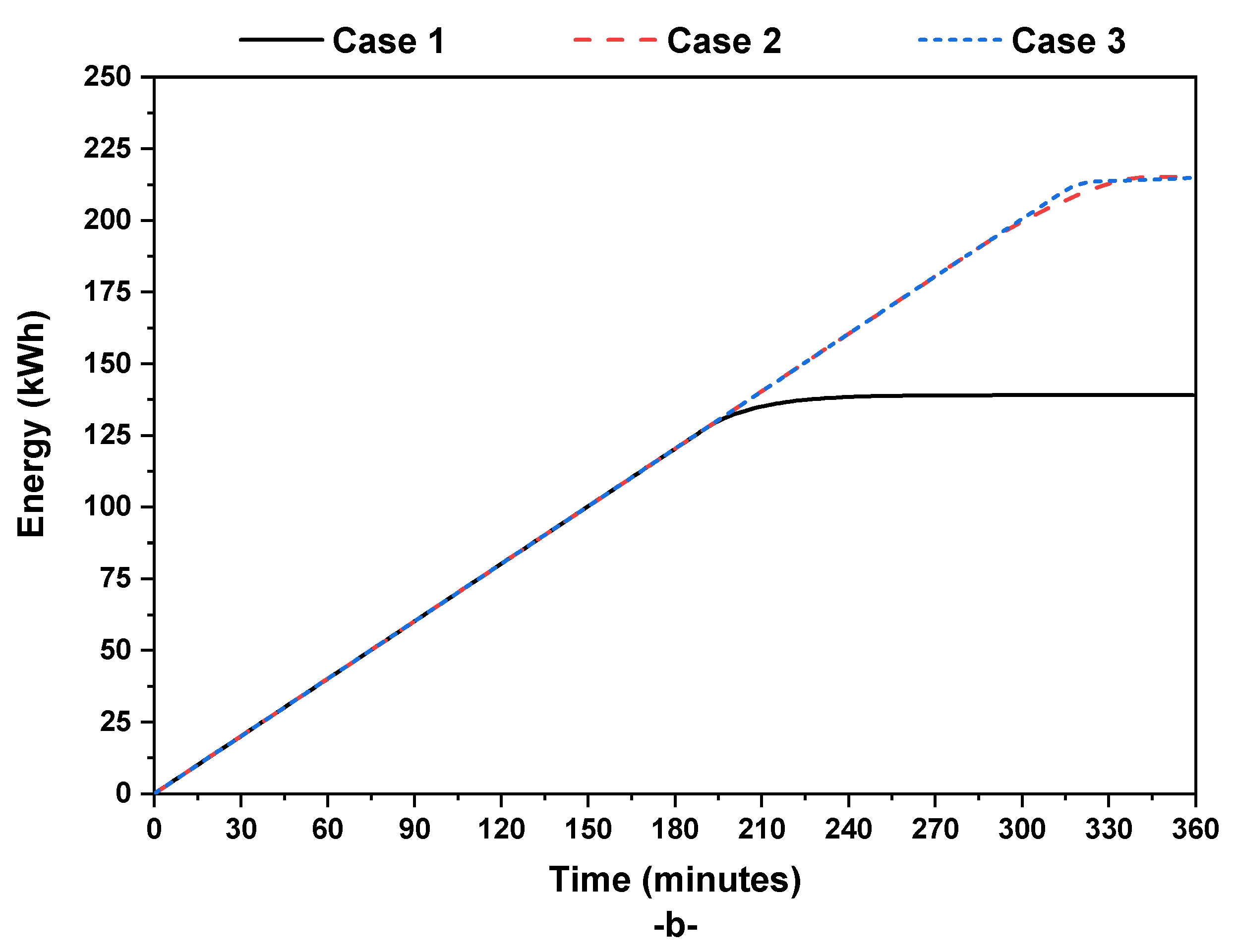
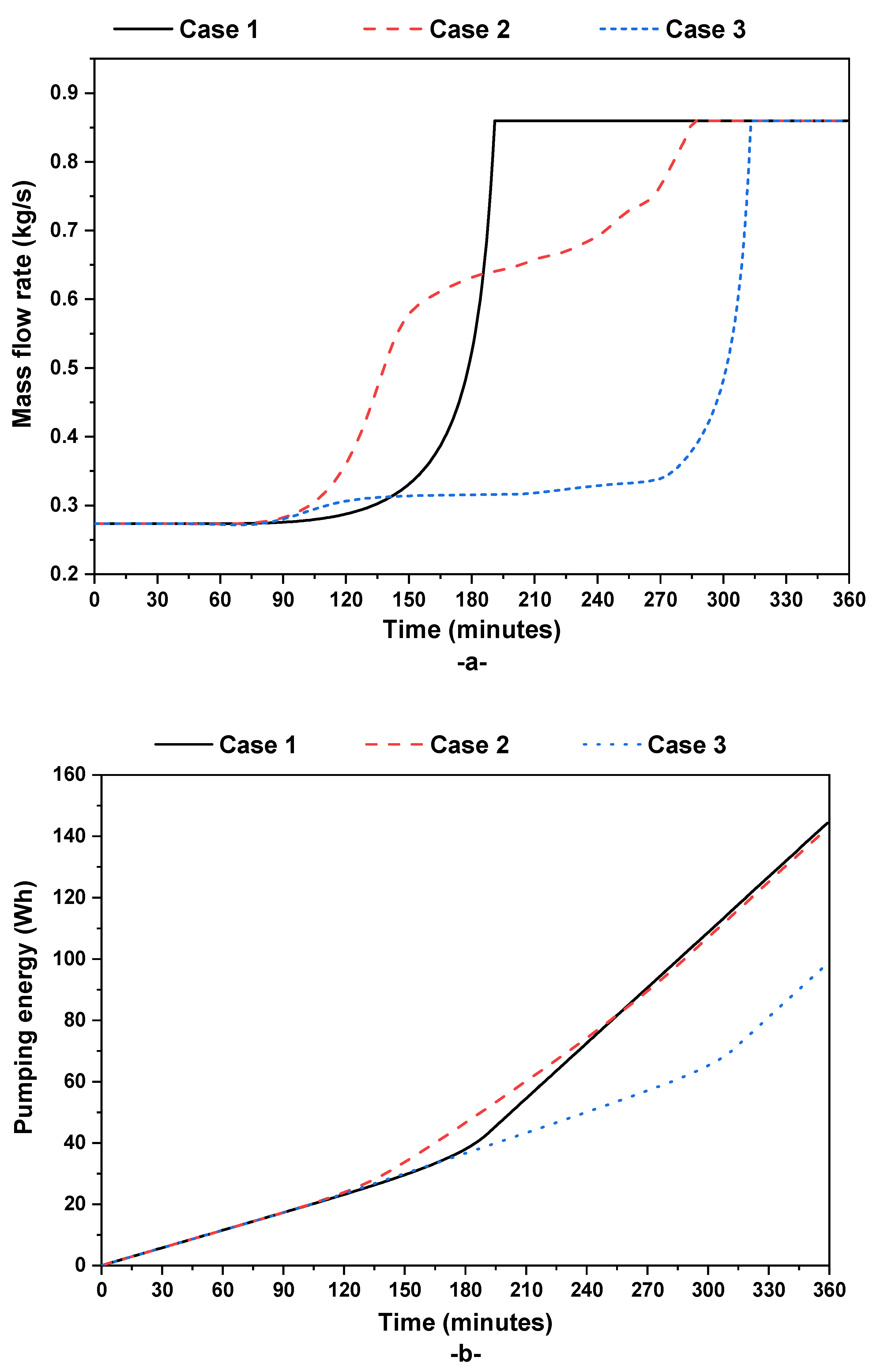
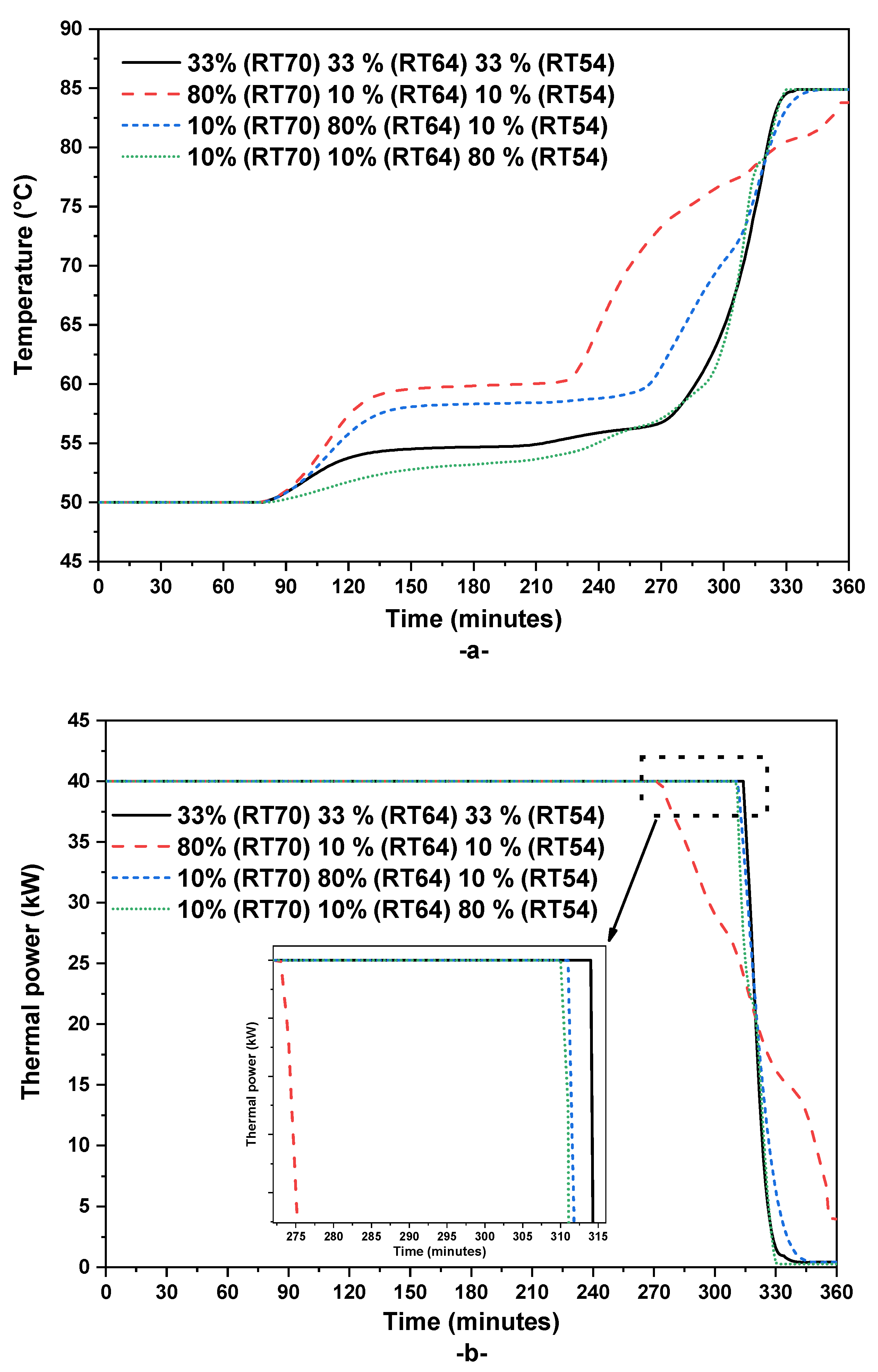
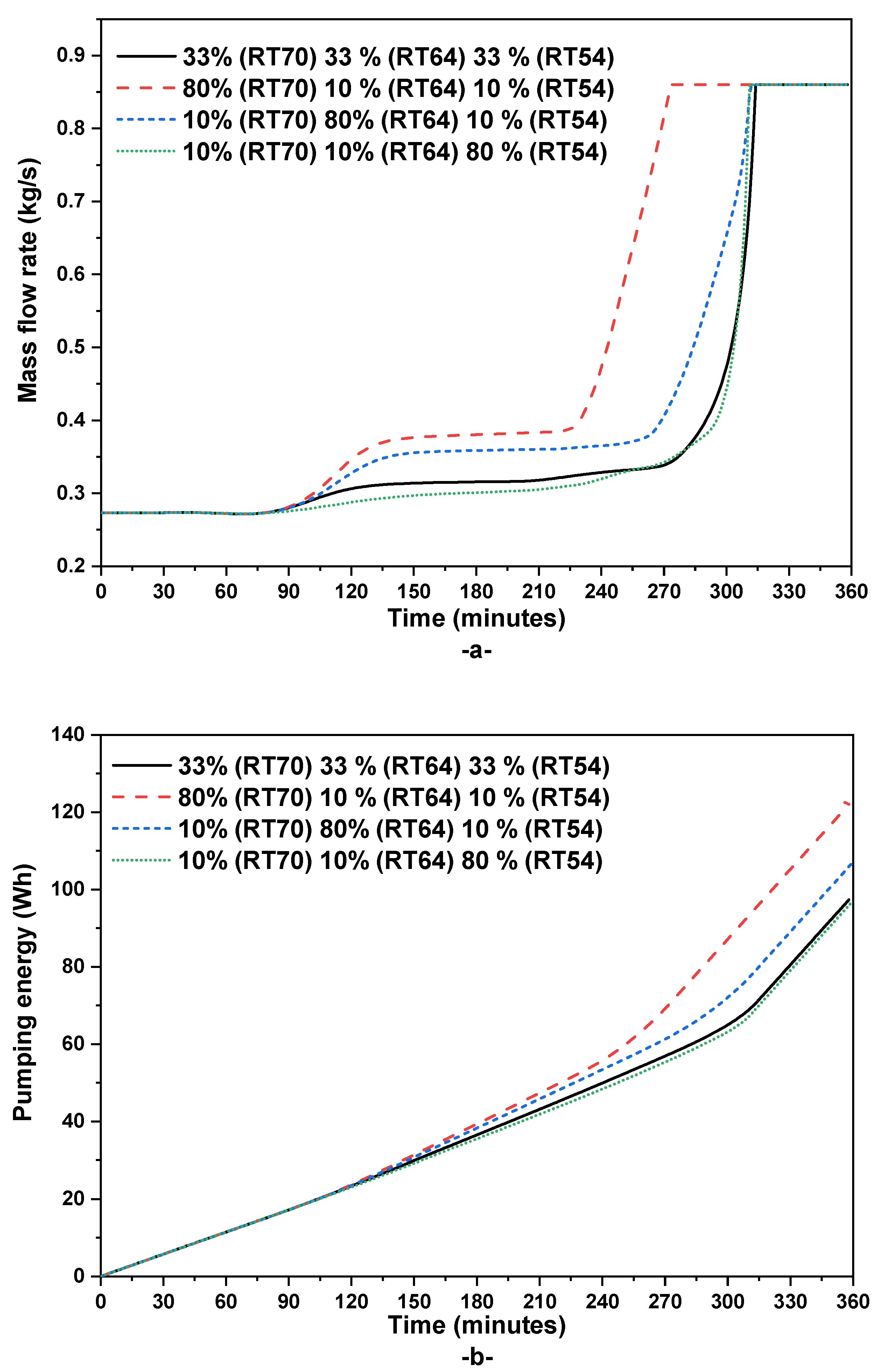
| Properties | Water | PCM RT 70 | PCM RT 64HC | PCM RT 54HC |
|---|---|---|---|---|
| Density (kg/m3) | 998 | 880/770 | 880/780 | 850/800 |
| Thermal conductivity (W/mK) | 0.6 | 0.2 | 0.2 | 0.2 |
| Heat capacity (kJ/kgK) | 4.18 | 2 | 2 | 2 |
| Latent heat of fusion (kJ/kg) | 334 | 260 | 250 | 200 |
| Melting point (°C) | 0 | 69–71 | 63–65 | 53–54 |
Disclaimer/Publisher’s Note: The statements, opinions and data contained in all publications are solely those of the individual author(s) and contributor(s) and not of MDPI and/or the editor(s). MDPI and/or the editor(s) disclaim responsibility for any injury to people or property resulting from any ideas, methods, instructions or products referred to in the content. |
© 2024 by the authors. Licensee MDPI, Basel, Switzerland. This article is an open access article distributed under the terms and conditions of the Creative Commons Attribution (CC BY) license (https://creativecommons.org/licenses/by/4.0/).
Share and Cite
Ali, E.; Ajbar, A.; Lamrani, B. Numerical Investigation of Thermal Energy Storage Systems for Collective Heating of Buildings. Buildings 2024, 14, 141. https://doi.org/10.3390/buildings14010141
Ali E, Ajbar A, Lamrani B. Numerical Investigation of Thermal Energy Storage Systems for Collective Heating of Buildings. Buildings. 2024; 14(1):141. https://doi.org/10.3390/buildings14010141
Chicago/Turabian StyleAli, Emad, Abdelhamid Ajbar, and Bilal Lamrani. 2024. "Numerical Investigation of Thermal Energy Storage Systems for Collective Heating of Buildings" Buildings 14, no. 1: 141. https://doi.org/10.3390/buildings14010141
APA StyleAli, E., Ajbar, A., & Lamrani, B. (2024). Numerical Investigation of Thermal Energy Storage Systems for Collective Heating of Buildings. Buildings, 14(1), 141. https://doi.org/10.3390/buildings14010141







